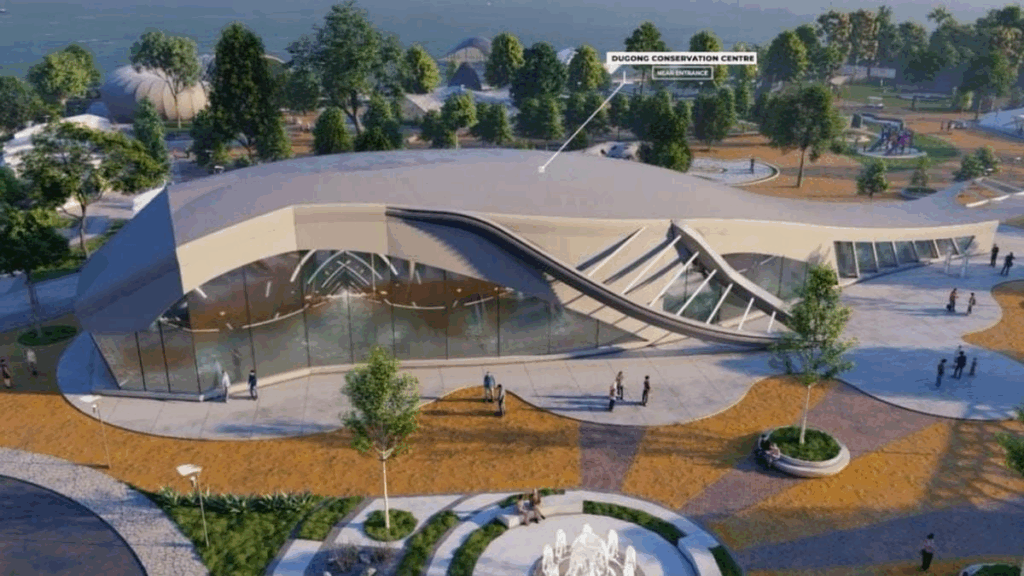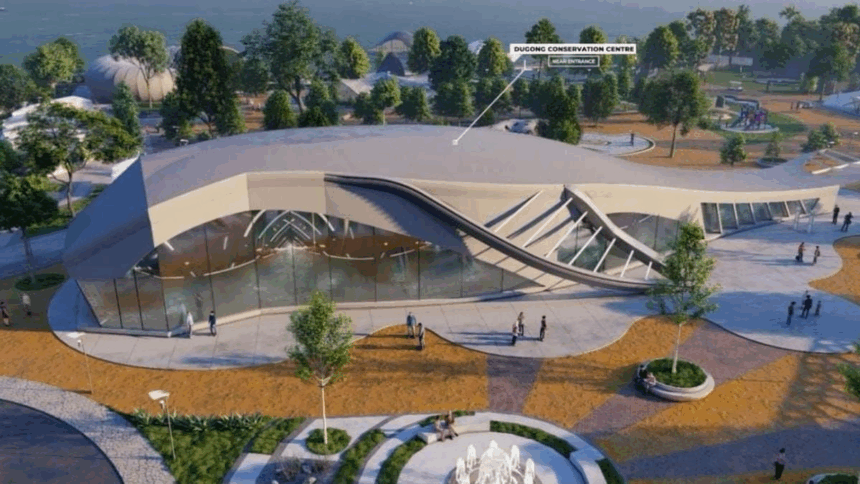
A Coastal Landmark with a Conservation Mission
Along the coastal stretch of Manora in Tamil Nadu, a distinctive architectural project is taking form. The International Dugong Conservation Centre has been envisioned not only as a facility for marine research but also as a public landmark that strengthens awareness of conservation. Dugongs, gentle marine herbivores that graze on seagrass meadows, are among the most threatened marine species. Their declining numbers have created an urgent need for protection through scientific study, habitat preservation, and public education. The new centre addresses these needs with a design that merges architectural symbolism and ecological purpose.
Architecture Inspired by Marine Life
Picture Courtesy- YouTube/ Ramesh Babu
The focal point of the project is a primary structure designed to resemble the shape of a dugong. This symbolic choice integrates narrative and function, enabling visitors to connect visually and emotionally with the centre’s mission. The building is arranged over two levels and accommodates public exhibitions, a marine museum, a theatre for immersive viewing, landscaped parks, and leisure spaces such as a cafeteria and an open performance area. The arrangement of spaces has been planned to encourage a natural flow from entrance to exit, allowing visitors to move between educational galleries, interactive installations, and open air zones.
The positioning of the structure has been carefully considered in relation to natural light, sea breezes, and the surrounding landscape. By orienting the building with respect to its coastal setting, the design ensures comfort for visitors while maintaining a minimal environmental footprint.
Functional Zones for Different Users
Picture Courtesy- X/ United Thanjavur
The master plan is organised into three distinct zones, each dedicated to a specific function.
- Public Zone
This includes the dugong shaped building, the souvenir shop, landscaped plazas, and all spaces open to general visitors.
- Semi Public Zone
This section contains research and training facilities, including a dugong monitoring laboratory and a seagrass ecology laboratory. These spaces are designed for scientists, conservationists, and students.
- Private Zone
This area houses staff quarters, service infrastructure, and administrative support spaces, positioned to ensure that daily operations remain separate from public activities.
Technology and Interpretation
Picture Courtesy- X/ United Thanjavur
The interior layout supports a range of presentation methods aimed at deepening visitor understanding of marine life. The design incorporates virtual reality and augmented reality experiences, three dimensional projection systems, and holographic displays to recreate marine environments without disturbing natural habitats. The spatial sequence moves from introductory information about dugongs to detailed ecological contexts, allowing learning to develop gradually as visitors progress through the building.
Educational content also emphasises the relationship between dugongs and seagrass ecosystems, illustrating how habitat loss directly impacts species survival. The galleries have been arranged to create thematic continuity, with each section complementing the previous one.
Sustainability and Environmental Integration
Picture Courtesy- YouTube/ Know our Town
Given the site’s location in a coastal regulation area, environmental considerations have shaped every aspect of the design. Solar energy generation, water recycling systems, and the use of regionally sourced materials are central to the construction plan. Landscaping will use native plant species to protect soil, reduce the need for irrigation, and create a natural visual transition between built and unbuilt areas.
A dedicated area called the fishermen’s cove will present the history and traditions of local fishing communities. This feature reinforces the importance of community participation in conservation and acknowledges the knowledge held by those who depend on the sea for their livelihood.
Part of a Larger Global Network
Picture Courtesy- YouTube/ Ramesh Babu
Although based in Tamil Nadu, the International Dugong Conservation Centre is intended to connect with global marine conservation initiatives. Flexible meeting rooms, seminar spaces, and research facilities will support collaboration with scientists and organisations across the world. The data and findings generated here are expected to contribute to international strategies for dugong protection and habitat restoration.
Architecture as Storytelling
Picture Courtesy- YouTube/ Ramesh Babu
The decision to model the building in the form of a dugong transforms it into an architectural narrative. Visitors encounter conservation messaging not only through exhibits but also through the physical form of the structure itself. The curves, proportions, and overall silhouette evoke the marine mammal, reinforcing the purpose of the visit from the moment one approaches the site.

Ar. Pranjali Gandhare
Architect | Architectural Journalist | Historian








